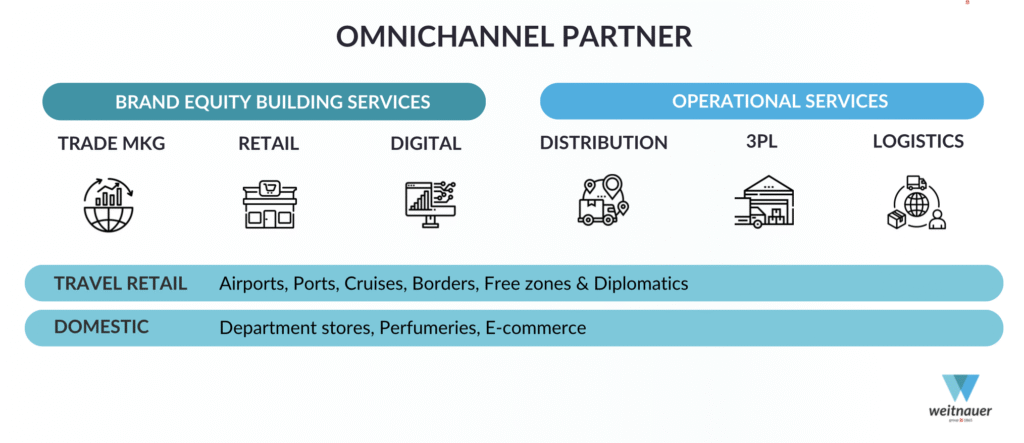Omnichannel distribution is a strategy in which product flows, inventory, and customer data are fully integrated across all channels—both online and offline. The goal is to deliver a consistent, unified customer experience and empower shoppers to choose how and where they interact with a brand.
The core objective is to allow customers to buy, receive, and return products through the channel of their choice—whether in-store, online, or cross-border—with every touchpoint connected to enable a seamless, frictionless journey.
At Weitnauer Group, this is not just a strategy—it’s our operating model. We merge brand equity building services with operational excellence across two major channels: Travel Retail and Domestic Markets. This ensures that the brands we represent are visible, accessible, and consistent wherever the consumer engages with them.
In this article, we will explore the fundamentals of omnichannel distribution and its strategic role in building brand equity—with a special focus on how this applies to luxury brands.
4 Reasons to Choose Omnichannel Distribution Model?
- Unified Customer Experience: According to Qualtrics Research, nearly 80% of customers engage with multiple channels before making a purchase. They expect to move fluidly between digital and physical touchpoints. Whether they browse online and pick up in-store or begin a purchase on mobile and complete it on desktop, the journey must feel consistent and connected.
At Weitnauer, we ensure that each channel—whether Travel Retail or Domestic—is aligned to deliver a cohesive brand experience.
- Increased Sales Opportunities: Being present across multiple channels expands a brand’s reach and increases sales potential. Research shows omnichannel operations can raise purchase rates by up to 287% (WiserNotify, 2025).
At Weitnauer, we apply this model across markets. A recent example is our expansion into Uruguay, designed to create regional synergy and ensure consistency across our Southern Cone entities in Paraguay and Brazil. By aligning brand presence and messaging across all three markets, we deliver unified marketing strategies, broader outreach, and seamless access to the same product portfolio—maximizing performance across channels.
- Customer Retention and Loyalty: A recent report from PwC that 86% of shoppers are willing to pay more for superior experiences that prioritize convenience, reliability, and consistent presentation.
- Optimized Inventory and Fulfillment: Centralized inventory management minimizes out-of-stocks, prevents overselling, and supports faster, more flexible deliveries and returns.
At Weitnauer, our distribution network spans 22 warehouses across 4 continents, reaching over 100 countries. Such scale requires more than operational efficiency—it demands a fully integrated omnichannel approach. By connecting systems across markets and channels, we ensure product availability, streamline fulfillment, and deliver consistent service—no matter where or how consumers choose to shop.
Key Components of an Omnichannel Distribution System
- Integrated Inventory Management: All stock, regardless of location, is visible and managed in a central system to support fulfillment from any channel.
- Synchronized Order Processing: Orders from any channel can be processed and fulfilled by warehouses, stores, partners, or dropshippers.
- Unified Customer Data: Shopper profiles and preferences are maintained across channels for personalization and targeted marketing.
- Flexible Fulfillment Options: Includes ship-to-home, buy online/pick up in store (BOPIS), curbside pickup, and easy returns across channels.
- Consistent Brand Messaging: Marketing, pricing, and product information remain harmonized to avoid confusion and boost trust.
Real-World Omnichannel Example: Weitnauer Group
A strong example of omnichannel distribution in action is Weitnauer, an international brand partner that seamlessly merges brand equity building with operational excellence.
They integrate multiple aspects of business to deliver consistent customer experiences across both travel retail and domestic markets

Brand Equity Building Services:
- Trade Marketing: In-store brand activations and promotions in prestige locations like airports and high-end shopping areas.
- Retail: Branded stores and concessions with consistent visuals and brand identity.
- Digital: Mobile and web campaigns connecting with shoppers before, during, and after their purchase journey.
Operational Services:
- Distribution: Supplying products to airports, ports, cruises, and border duty-free outlets.
- 3PL (Third-Party Logistics): Fulfillment, packaging, and delivery for both B2B and B2C clients.
- Logistics: Coordinated transport, warehousing, and supply chain management for on-time delivery.
Weitnauer Distribution Channels:
- Travel Retail: Airports, sea ports, cruises, borders, free zones, and diplomatic duty-free.
- Domestic Sales Channels: Department stores, perfumeries, and e-commerce platforms.
By combining physical retail, digital engagement, and logistics excellence, Weitnauer ensures luxury brands hold a consistent presence and remain accessible no matter where customers shop.
This is omnichannel distribution in action—bridging marketing, retail presence, and supply chain infrastructure into a single cohesive ecosystem.
Challenges in Omnichannel Distribution
- Inventory Visibility: Real-time tracking across locations is critical to avoid stockouts or excess inventory.
- Logistics and Speed: Offering same-day pickup or fast cross-channel fulfillment requires sophisticated infrastructure.
- Consistent Data and Messaging: Mismatches in pricing, promotions, or product details harm brand trust.
Conclusion
Implementing omnichannel distribution is no longer an optional strategy—it’s essential for modern commerce. By dissolving the barriers between platforms, brands can meet customers wherever they are and however they prefer to shop.
As the Weitnauer example shows, true omnichannel success comes from uniting marketing, retail, and logistics into one seamless framework. In the age of heightened expectations, this is how businesses create lasting customer loyalty and sustainable growth.


